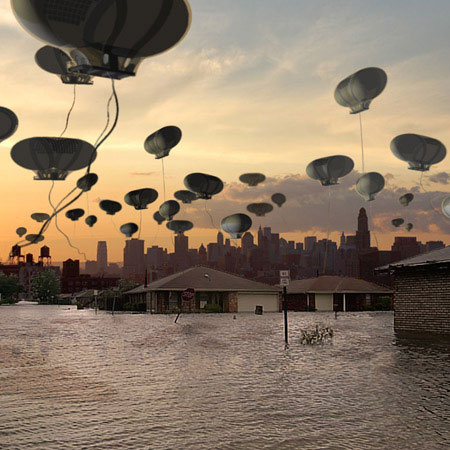The results of the What if New York City. . . Design Competition for Post-Disaster Provisional Housing have been announced, with this proposal by Studio Lindfors among the projects in the Selected Entries category.
The competition sought proposals for temporary housing solutions in the event of New York City being struck by a catastrophic coastal storm.
Cloud City would house residents in a series of pre-fabricated, helium-filled balloons, that would float temporarily above the flood-stricken city.
See Geoff Manaugh's take on this story over on BLDGBLOG
More airships on Dezeen:
Manned Cloud by Jean-Marie Massaud
Strato Cruiser "lifestyle Zeppelin"
Aeroscraft ML866 hybrid aircraft
Here is a full explanation of Cloud City from Studio Lindfors:
--
Though perhaps an unusual proposal, CLOUD CITY is literally an uplifting experience that will allow communities to remain intact as they pull themselves out of the rubble. CLOUD CITY is a continuation of the dream captured in the built form of the Empire State Building, the spire of which was constructed as a landing platform for dirigibles. The dream of floating amongst the clouds above a magical and ever changing cityscape.
The concept for CLOUD CITY is based on the desire to allow people to remain in their community as close to their homes as possible. This would allow residents to remain an active part in the rebuilding of their community, while fostering a sense of security. The way to achieve this is to literally float a layer of provisional housing over the damaged or destroyed portions of the City. Once airborne, the floating homes allow construction crews below to work unimpeded, speeding up the recovery effort. This in turn reduces cost overruns and unnecessary delays.
Inflatable homes would be pre-fabricated and stored in warehouses for deployment as required. Each home consists of three basic components: an inflatable bladder, a rigid core, and a metal and wood platform. The bladder would consist of two compartments, filled with pressurized helium (which is non-combustible). The pressurized gas would give shape to the tailored and stitched fabric shell, creating an open living space within. Made from recycled polyester fabric, the balloon has a large surface area suitable for mounting of flexible solar panels for generating electricity. Within this living space is a rigid core which contains an efficient kitchenette and bathroom, along with plumbing and electrical services. The 300sf living space is open, and can be configured in many ways, with up to three bedroom spaces suitable for a family of four.
The homes can be rapidly deployed with minimal site preparation. They are intended to ‘plug in’ to existing utility services, and can be deployed by a team of four workers in roughly an hour. Once in place, access to the floating home is gained by lowering the entire home to the anchorage point (either an old rooftop, or temporary boardwalks). A keyed hand crank winch would guide the home down to allow for the mobility impaired to gain easy access via a gangplank. The homes are minimally appointed, in an effort to reduce overall fabrication costs. They are fully reusable, and can be stored indefinitely.
About Studio Lindfors
Studio Lindfors is a design firm based in New York, New York, founded in 2006 by Ostap Rudakevych. We are committed to working closely with our clients to achieve projects of design excellence. The firm is versed in a wide range of project types, while remaining dedicated to the pursuit of speculative proposals that explore the realm of the fantastic. Most recently Studio Lindfors completed an exhibit design for the ‘Design for the Other 90%’ exhibition installed at the Cooper-Hewitt National Design Museum. Currently Studio Lindfors is developing drawings for the ‘House of Inconvenience’ as well as the entirely un-plugged ‘Free House’.

